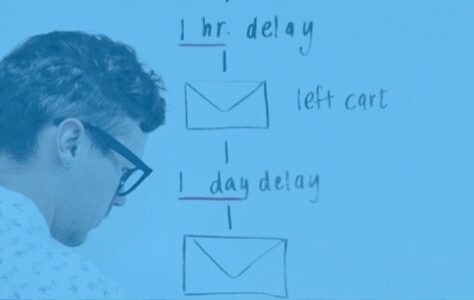We live in an era of overconsumption, overinformation. Our users, our consumers have more choices than ever. To respond to this, our companies must transform and put their customers back at the center of the shopping experience instead of the product.
Today, companies that have already put their consumers back at the heart of their shopping experience are the big winners in this race. Companies that have been able to use this leverage to gain their share of the market, even if they are not the most powerful, nor the richest. Just look a little behind us: why Google beat out Yahoo, why Apple knows how to sell a phone two or even three times more expensive than other manufacturers or why Uber very quickly made you forget about traditional taxis.
The seamless consumer experience is halfway between human-centered design and the company's business strategy. It can be defined as:
The mindset of a company to consistently deliver the right product to the right consumer in the right context through the best channel.
The 4 pillars of the seamless experience are then the consumer, content, context and channel.
The 4 Cs
# The consumer
The consumer is the starting point. It must be in all cases, from the smallest to the most important design of a new shopping experience.
A consumer is a user, a human, expressing frustrations or needs that the company can meet by providing a product or service.
To begin with, it is important to define the consumer in 3 dimensions.
- The demographic dimension: who is our consumer? Their age, their professional situation, their place of residence, etc.
- The behavioral dimension: what are the expectations or frustrations of the consumer. It is necessary to identify its main need to which the company can respond while creating value. (KING)
- The relational dimension
Knowing your consumer is the first weapon to win on the minefield of competition. A very good example comes from the video game sector and in particular that of the Japanese Nintendo's Wii. In 2006, it's the battle swing for the giants of the sector, it's the year of the release of the Playstation 3 (Sony) and the XBox 360 (Microsoft). These consoles are technological monsters, carrying with them competitive processors and graphics engines. Nintendo, unable to afford such technology, decided to conduct extensive research on home console consumers. The conclusion, the two giants focus on a target of “Hardcore gamers”. With this insight, Nintendo decided to market a console for casual gamers, a target more interested in the user-friendliness of the game, its lightness than by its graphics performance or the speed of its processors. In the same year, Nintendo gave the world a new gaming experience with the release of the Wii. In barely a month, the youngest exceeded the sales of its two big sisters in the United States.
# The context
Once the company has a fairly precise knowledge of its consumer, it is important to place the latter in context. Is he at work? In the transports ? Chatting with a friend? At table ?
Bill Buxton, a researcher at Microsoft, theorized the concept of Place-ona. An extension of the persona, which places the consumer in a precise, dynamic and constrained context.
An example from the retail world: if your consumer uses a shopping cart to do their shopping, they probably have both hands on the handle. Direct interaction with your smartphone becomes complicated. It is then perhaps necessary to think of its in-store consumer experience on the basis of a system of voice interactions.
Understanding the customer's context is crucial to delivering a seamless, frictionless experience. A very good example is Slack and its internal notification system. Slack, the leader in business messaging, is used by millions of businesses around the world. Companies that often have access to less expensive messaging software or even already integrated into their system (Skype with Office). So why do they choose to turn to Slack? This is mainly due to the tool's notification system. In addition to a seamless user experience, each product decision is carefully considered taking into account the context of their customers (professionals) and the main objective (fostering communication between teams and collaborators).
 The Slack notification system tree
The Slack notification system tree
As you can see from the diagram above, Slack has thought about the context their customers are in when sending a notification. Messaging then only sends notifications at the most inconvenient times for their customers while respecting their digital well-being and the right to disconnect. It is this system that has participated in the emergence of the company, making the SAAS the most growing in history. It only took them “only” two years to reach $100 in annual revenue.
# The contents
Now that the company knows its consumer and the latter's context, it is time to think about the content it can deliver, sell, subscribe to, etc. Behind the word content is any product, service or process that I can sell to a consumer.
To deliver the right content, it is necessary to think in two dimensions this time :
- The front-end: This is the dimension in interaction with your consumer. The most palpable and tangible for him. It is necessary to deliver to the consumer a product which interfaces as naturally as possible with his expectations and his needs. Snapchat is a very good example. By observing social network consumers, they designed their video interfaces vertically, a novelty in the mobile world where the vast majority of videos were still viewed in a vertical format. By getting closer to the natural use of the smartphone, Snapchat has succeeded in establishing itself (for a while) as the leader in sharing. Following this, their success was a textbook case, a new design paradigm.
- The back-end: This is the information present in the interface. The key here is to provide personalized information for your consumer in a specific context. The best example here is the emergence of conversational design among many players, pure-players like brick and mortars. The figures speak for themselves: the majority of e-commerce sites in France today have a conversion rate of around 3% (source: SmartInsight). Most of these sites offer smooth content for all of their targets. Actors who have integrated conversational design into their consumer experiences now manage to convert around 50% and above all to retain their customers through a personalized customer and consumer relationship.
# The canal
If the company has followed the first 3 points correctly, it knows its customer and the context in which the latter finds himself, and also knows what content to deliver to him to create value. To conclude its seamless customer experience, it is necessary to deliver the content through the best of channels.
 Grammarly, a company that knew where to find its client
Grammarly, a company that knew where to find its client
Businesses need to know where their customers are. They must target with ballistic precision the channel of communication and deployment of their content. A final example is that of Grammarly, leader in spelling correction (English-speaking for the moment). Grammarly to reveal some of the strategic levers of their success. One of the main ones was the channel. Instead of addressing the general public directly, Grammarly has installed itself at the heart of the Office suite and as a Chrome extension to be closer to professionals who need their help in writing professional emails, reports, auditing, etc. They were able to grow their user base in a very short time by catering to their audience in the best places.
To choose tomorrow the best channels for the company, 3 indicators are important :
- The cost: how much could it cost the company to attract customers via this channel? The company must always keep an eye on indicators such as CAC or LTV to remain competitive,
- Maturity: is your customer mature enough on this channel or is he still suspicious? It is important to find a channel that your client trusts (the Office suite) and knows how to use,
- Control: is the channel that the company wants to invest malleable? Customizable? Does the channel provide APIs for third parties? It is important to be careful that your content is not cannibalized by the distribution channel. For example, basing all of its communication on Instagram can be dangerous when we know that today the social network is preparing to remove likes.
Conclusion
To deliver a seamless customer experience, it is necessary to strategically align the 4 points: consumer, context, content and channel. By placing the customer at the center of the company's concerns and of your business strategy, the company can quickly respond to the latter's needs by delivering a useful, sensitive and personalized experience at the right time and in the right place.
A company like Grammarly, for example, has no interest in integrating with smartphones yet, as SMS language is still predominant. Snapchat is not the right channel for B2B companies, the target is still too young, etc. So many counterexamples that push the company to rethink its design, distribution and loyalty processes to put the end customer at their center.
This seamless customer experience design process can prove prolific at all stages from acquisition to retention to loyalty.
It is also important to keep in mind the expiration of the experience or its need for permanent updating, like software. In fact, the uses, the context and the needs of customers evolve according to technological advances, the emergence of new products and new needs.
Designing a seamless customer experience should remain a humble process that checks the consistency of its actions and the impact of its choices on customers. Placing the customer at the center of our considerations today means placing ourselves on the right side of history, preparing for the business challenges of tomorrow, which are more ethical, more responsible and more sustainable.
UX-Republic Experts team
Our next trainings
VISUAL THINKING: CONCRETE YOUR IDEAS # Paris
UX-REPUBLIC Paris
11 rue de Rome - 75008 Paris
DIGITAL ACCESSIBILITY AWARENESS #Paris
SMILE Paris
163 quay of Doctor Dervaux 92600 Asnières-sur-Seine
DIGITAL ACCESSIBILITY AWARENESS #Belgium
UX-REPUBLIC Belgium
12 avenue de Broqueville - 1150 Woluwe-Saint-Pierre
ACCESSIBLE UX/UI DESIGN # Paris
SMILE Paris
163 quay of Doctor Dervaux 92600 Asnières-sur-Seine
AWARENESS OF DIGITAL ECO-DESIGN # Belgium
UX-REPUBLIC Belgium
12 avenue de Broqueville - 1150 Woluwe-Saint-Pierre
STORYTELLING: THE ART OF CONVINCING # Paris
SMILE Paris
163 quay of Doctor Dervaux 92600 Asnières-sur-Seine
UX/UI ECO-DESIGN # Paris
SMILE Paris
163 quay of Doctor Dervaux 92600 Asnières-sur-Seine
DESIGN THINKING: CREATING INNOVATION # Belgium
UX-REPUBLIC Belgium
12 avenue de Broqueville - 1150 Woluwe-Saint-Pierre
MANAGING AND MEASURING UX # Paris
SMILE Paris
163 quay of Doctor Dervaux 92600 Asnières-sur-Seine









